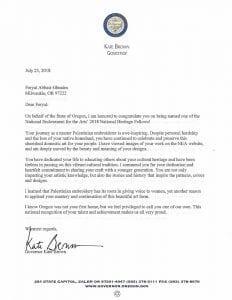Returning to work after attending the Middle Oregon Treaty of 1855 Conference, I am newly aware that I am returning to America after visiting the Warm Springs Nation. This sovereign nation that pre-existed the establishment of the United States, holds inherent rights to their lands – including access to millions of acres ceded to the US through the Treaty for usual and customary practices like hunting and gathering. These rights are not only acknowledged, but protected by the Treaty, a nation-to-nation agreement with the same legally and ethically binding strength and significance as other international treaties.
The original document resides in a climate-controlled vault in the National Archives in Washington DC, however it was temporarily on display at the Museum at Warm Springs through Nov 3, 2018. This unique access to the Treaty paralleled the Museum’s celebration of its 25th Anniversary, and spurred tribal leadership to coordinate the Treaty Conference. Many Native and non-native allies came together to better understand the historical context that established the Treaty; to reflect on the growth and development of tribal governance despite the overwhelming loss of language, cultural practices, lands and people; and to imagine and plan for a future beyond surviving, but one of thriving.
Warm Springs Tribal Council member, Valerie Switzler, invited Oregon Folklife Network to interview participants and document their reflections and reactions. Of high importance to her was engaging tribal youth in the process. OFN was honored by the invitation and donated our time in sponsorship of the event. With the help of superintendent Ken Parshall, we reached out to Fieldschool alumni, and Warm Springs sophomores Dylan Heath, Taya Holiday, and Kathryce Danzuka attended on Friday and took leadership roles in running the video camera, asking thoughtful questions, and ensuring that release forms were properly filled and returned. They showed great respect and professionalism, though I was delighted to see them relax into some light-hearted teenager fun after their work was through.
Interviews spanned a variety of perspectives, from Native American Rights Fund lawyer (and former UO Duck) Charles Wilkinson, to elder and language teacher Arlita Rhoan. Incoming Executive Director of the Museum at Warm Springs (and former Poet Laureate) Elizabeth Woody, who expertly coordinated this important event, also provided her reflections for this record, all of which is going back to the Tribal Archives. Their thoughts co-mingle with my own reflections as the days between me and the event grow. I yearn for more time to steep in my feelings and better understand and act on my sense of urgency to respond. But I am back in America now. The prayer songs fade in my ears, but for the people of the Confederated Tribes of Warm Springs, and the 500+ sovereign nations who permit US activities on the land that has been theirs since time immemorial, those songs resound often and strong.








